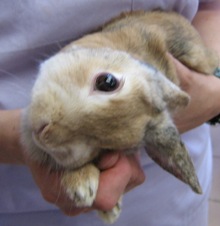Upper Respiratory Disease in Rats
A rat that sneezes a lot, has more tears than normal or has crusty eyes, or has an audible wheeze or crackle, is showing signs of a respiratory infection.
Respiratory infections in rats are often caused by viruses. Many times the viruses are harbored in older rats that aren’t showing any outward signs of infection yet they are still capable of infecting younger rats. This is one reason why it is important to avoid mixing rats of different ages and different origins together.




 Rabbits sometimes develop a head tilt that gets progressively worse until they roll uncontrollably when they try to move. This condition is commonly known as "wry neck". There are many different diseases that can cause wry neck such as an ear infection, a parasite known as Encephalitozoon cunniculi (often just called E. cunniculi or encephalitozoonosis), and others. Depending on the cause, treatment is often quite successful if initiated early. Sometimes the treatment arrests the underlying disease but the rabbit continues to have a head tilt. Most of these learn how to live with their new view of the world and many gradually return to almost a normal posture.
Rabbits sometimes develop a head tilt that gets progressively worse until they roll uncontrollably when they try to move. This condition is commonly known as "wry neck". There are many different diseases that can cause wry neck such as an ear infection, a parasite known as Encephalitozoon cunniculi (often just called E. cunniculi or encephalitozoonosis), and others. Depending on the cause, treatment is often quite successful if initiated early. Sometimes the treatment arrests the underlying disease but the rabbit continues to have a head tilt. Most of these learn how to live with their new view of the world and many gradually return to almost a normal posture. Rabbits often develop a cloudy appearance to their eyes. The eyes may become cloudy on the cornea (surface of the eye), the lenses, or any of the chambers inside. There may be many different causes for this disorder ranging from a parasite, Encephalitozoon cunniculi, to a corneal scratch or ulcer, cataracts, or various infections. A rabbit eye can quickly get damaged beyond repair so any time you see a change in an eye, a health consulta
Rabbits often develop a cloudy appearance to their eyes. The eyes may become cloudy on the cornea (surface of the eye), the lenses, or any of the chambers inside. There may be many different causes for this disorder ranging from a parasite, Encephalitozoon cunniculi, to a corneal scratch or ulcer, cataracts, or various infections. A rabbit eye can quickly get damaged beyond repair so any time you see a change in an eye, a health consulta